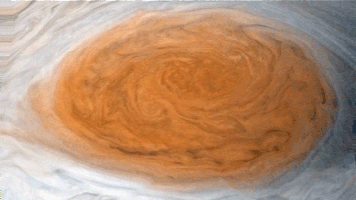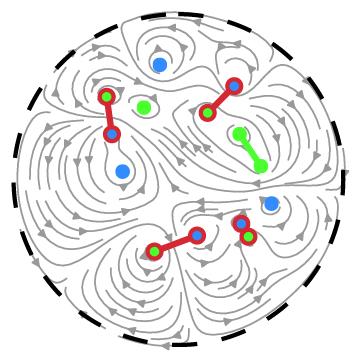Two Australian studies published this week offer the first proof of a 70-year-old theory of turbulence.
“The studies confirm a seminal theory of the formation of large-scale vortices from turbulence in 2D fluid flow, where the large vortices emerge from an apparent chaos of smaller vortices,” says author Prof Matt Davis, FLEET’s lead on the University of Queensland paper.
Fluids restricted to flow in two-dimensions can be observed in systems ranging from electrons in semiconductors, to the surface of soap bubbles, to atmospheric phenomena such as cyclones.

“One of the commonly observed features in such 2D flow is the formation of large-scale swirling motion of the fluid from the initially chaotic swirling motion typical of turbulent flow, such as Jupiter’s famous Great Red Spot,” says the Monash study’s lead author, Shaun Johnstone.
Turbulence, with its seemingly random and chaotic motion of the fluid, is a notoriously difficult problem, for which there is no general theoretical description. In fact, the Clay Mathematics Institute offers a million dollar prize to anyone that come up with a theory of turbulence.
There is, however, a simple theory, proposed in 1949 by the Nobel laureate Lars Onsager, to explain the formation of large-scale vortex motion from initially turbulent 2D flow.
Despite the appeal of Onsager’s physical picture of 2D turbulence, it can only make quantitative predictions for one special type of fluid: a ‘superfluid’, which flows without any viscosity or drag, and which can only be realised at extremely low temperatures. This had made a testing of Onsager’s theory difficult, until now.
“The study is broadly relevant to the emerging research field of non-equilibrium physics, and more specifically relevant to study of superfluids and superconductors,” says author Prof Kris Helmerson, who works with Johnstone in Monash’s School of Physics and Astronomy.
The new research is described in two papers out inScience today, with one experimental study led from FLEET’s Monash University node, and the other led from an EQUS/FLEET collaboration at the University of Queensland.
Why vortices & quantum turbulence
Most people are familiar with the concept of a vortex: whether the familiar twisting shape of a tornado, or the simple whirlpool that forms at a bathtub drains away through the plughole.
Vortices also occur in 2D systems where there is no vertical movement, such as at the surface of liquids, or in atmospheric system such as cyclones. In fact, 2D vortices cover a vast range of systems, from the superfluid movement of neutrons on the surface of neutron stars to the Atlantic Ocean Gulf Stream to the zero-resistance movement of electrons in high-temperature superconductors.

For 70 years, our understanding of such 2D vortex systems has been governed by Lars Onsager’s theory that as more energy is put into the chaotic mix of small vortices in a turbulent 2D system, over time the vortices rotating in the same direction would cluster to form larger, stable vortices – the system becomes ordered, rather than more chaotic.
In order to make his 1949 theory mathematically tractable, Onsager considered a superfluid, which he stated would have ‘quantised’ vortices (vortices with quantised angular momentum), a concept further developed by Richard Feynman.
Onsager’s theory described a 2D turbulent system’s energy congregating in high-energy, long-lived, large-scale vortices. This is an unusual equilibrium state where entropy decreases as a function of energy – the opposite of what we would consider ‘normal’ thermodynamic regimes.
[ad_336]
The Monash-led team generated vortex distributions at a range of temperatures and observed their subsequent evolution. States that began with relatively random distributions of vortices were seen to begin to order themselves, as Onsager had described. The University of Queensland study, on the other hand, directly generated two large clusters of vortices, flowing in opposite directions, testing the stability of this highly-ordered configuration.
Both studies experimented using Bose Einstein Condensates (BECs), a quantum state that exists at ultra-low temperatures, and in which quantum effects become visible at a macroscopic scale.
The researchers created turbulence in condensates of rubidium atoms using lasers, and observed the behaviour of the resulting vortices over time.
Both studies offer great promise for future studies of emergent structures in interacting quantum systems driven far from equilibrium.
The studies
The two studies: Giant vortex clusters in a two-dimensional quantum fluid and Giant vortex clusters in a two-dimensional quantum fluid were both published in Science today.

The University of Queensland study was led by Dr Tyler Neely and Prof Halina Rubinzstein-Dunlop from the ARC Centre of Excellence for Engineered Quantum Systems (EQUS), with theoretical support from FLEET’s Prof Matt Davis and Dr Matt Reeves along with researchers from the Centre for Quantum Science at the University of Otago, NZ. In addition to support of the Australian Research Council, funding was received from the Dodd-Walls Centre for Photonic and Quantum Technologies (NZ) and the Royal Society of New Zealand Marsden Fund.
In addition to researchers from the School of Physics and Astronomy, the Monash University study included authors from the Joint Quantum Institute, University of Maryland. This study was also supported by the Australian Research Council.
Studying non-equilibrium systems
While the results specifically describe turbulence, a notoriously difficult problem to describe theoretically, they are more broadly relevant to non-equilibrium physics – the evolution of systems far from equilibrium, in particular, the development of coherent, large-scale flow from by putting energy into a turbulent system.
[rand_post]
For centuries scientists have developed an excellent understanding of systems in equilibrium. But what happens to a system driven far from equilibrium remains one of the great unknown challenges of modern material physics.
At FLEET, non- equilibrium systems are used to pursue zero-resistance paths for electrical current.
FLEET is an Australian Research Council-funded research centre bringing together over a hundred Australian and international experts to develop a new generation of ultra-low energy electronics, motivated by the need to reduce the energy consumed by computing.